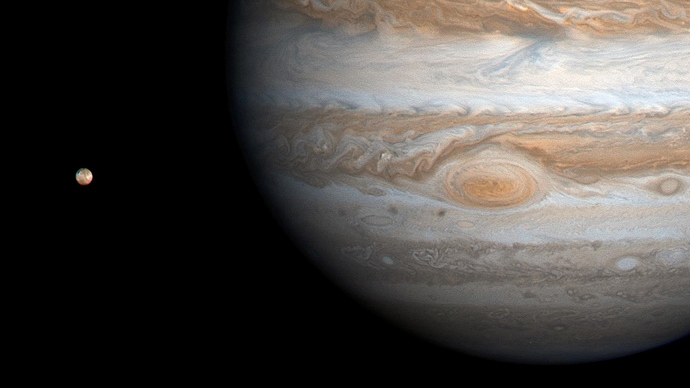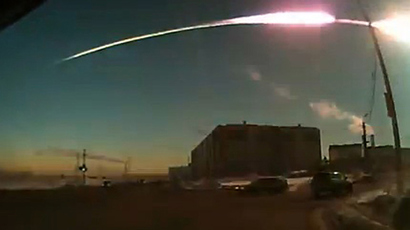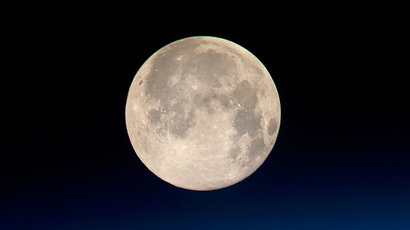Scientists say Jupiter moon landing best shot at finding habitable world

New research indicates Jupiter’s moon Europa is the most likely spot in our solar system to support life outside of the Earth, and NASA is currently developing a mission to explore the planet's icy shell and a subsurface ocean that may resemble our own.
Leading planetary researchers have published a paper detailing
plans for a possible “lander” to be launched within the next
decade. The plan includes instruments resembling those used by
the Mars Curiosity rover, such as a drill and a complement of
cameras. According to the paper - published this week in the
journal Astrobiology - the frozen, crackled surface of the moon
is a compelling choice for robot landers.
What makes Europa an appealing target for planetary scientists is
its subsurface ocean of liquid water - evidence for which was
first collected by flybys of robotic probes, including Voyager in
the 1980s and Galileo in the 1990s.
The moon is thought to be affected by Jupiter’s huge
gravitational presence, which scientists suspect generates tidal
forces that heat the interior of the celestial body and drive
geologic activity similar to plate tectonics. Of particular
interest are the dark, reddish fractures present throughout the
surface of the moon’s ice shell that suggest that water has
welled up and frozen on the moon’s surface.

NASA scientists have previously suggested that the red spots on
Europa’s surface mean that the moon acts as a sort of lava lamp,
carrying material from near the surface down into its ocean,
potentially transporting living organisms up towards the surface
as well.
Europa could potentially host extraterrestrial life, due to its
liquid ocean and warmer core which is thought to be similar to
Earth’s deep-water hydrothermal vents.
“Landing on the surface of
Europa would be a key step in the astrobiological investigation
of that world,” said Chris McKay, a senior editor of the
Astrobiology journal, who is based at NASA Ames Research Center
in California.
“This paper outlines the
science that could be done on such a lander,” said McKay.
“The hope would be that surface
materials, possibly near the linear crack features, include
biomarkers carried up from the ocean.”
Italian astronomer Galileo Galilei first discovered Europa in
1610. It wasn't until NASA’s Galileo reached the Jupiter system
in 1995 that scientists were able to study the moon’s surface in
greater detail.
Since then, some research has speculated that Europa’s ocean may
be fed by far more oxygen than was previously thought. Research
produced by scientist Richard Greenberg at the University of
Arizona in Tucson in 2009 theorized that beyond microscopic
organisms, the moon’s ocean could support some three million tons
of fish-like creatures.

"There's nothing saying there
is life there now," said Greenberg, who presented his work
at a meeting of the American Astronomical Society's Division for
Planetary Sciences in 2009. "But we do know there are the physical
conditions to support it."
So far, however, speculations of life on Europa are based on
calculations of flybys and imagery of its surface, as well as
evidence collected by instruments on the Hubble Space Telescope
and the Galileo spacecraft – both of which have confirmed the
presence of an atmospheric layer composed mostly of molecular
oxygen.
“The highest priority is active
sampling of Europa's non-ice material from at least two different
depths (0.5–2 cm and 5–10 cm) to understand its detailed
composition and chemistry and the specific nature of salts, any
organic materials, and other contaminants,” said the new
report.
“A secondary focus is
geophysical prospecting of Europa, through seismology and
magnetometry, to probe the satellite's ice shell and
ocean.”
The next steps for NASA and other space programs like the
European Space Agency (ESA) will be to further map out the
surface of Europa and select a prime landing spot for a robotic
lander. NASA’s Juno probe is currently scheduled to orbit around
the Jupiter system in 2016.
Meanwhile, the ESA plans to launch its JUICE mission (Jupiter Icy
Moons Explorer) in 2022 aboard an Ariane 5 rocket, arriving at
Jupiter in 2030 and spending some three years exploring the
planet’s moons, including Europa, Ganymede, and Callisto.
A number of previous plans to explore Europa have been abandoned
since the early 2000s, including the Europa Lander Mission, which
proposed a nuclear-powered lander. Another project known as Ice
Clipper - which would have used an impactor similar to NASA’s
Deep Impact mission – was also scrapped. The Deep Impact mission
launched into Earth’s moon in 2005, generating a plume of debris
which was then studied by a smaller spacecraft.















